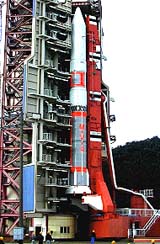| . |  |
. |
 Fluorine Enhances Boron Combustion In Energetic Propellants
Fluorine Enhances Boron Combustion In Energetic PropellantsChampaign - February 8, 2000 - Recent shock-tube experiments at the University of Illinois have shown that propellants containing fluorine can significantly enhance the combustion of energetic boron particles. "The number one performance factor for any rocket is the amount of energy obtained per pound of propellant," said Herman Krier, the Richard W. Kritzer Professor of Mechanical and Industrial Engineering at the U. of I. "The more energetic a material is, the less propellant a rocket must carry -- which means it can carry more payload." Liquid fuels and oxidizers provide more energy per pound than solid propellants, but liquids must be cryogenically cooled, adding to their cost and making them difficult to store. Solid propellants are cheaper to make, and can be stored safely for years -- even under harsh environmental conditions. Today's solid-fueled rockets use propellants that were developed in the 1960s and '70s. "These materials are safe and reliable, but not extremely energetic," Krier said. "New propellants being developed will likely contain highly energetic metals such as magnesium and boron." Boron has a low molecular weight and a high energy of combustion, making it an attractive additive for use in rocket propellants, Krier said. "But a thin layer of boron oxide that forms on the particle surface hinders combustion, resulting in long ignition delays. Chemical models have suggested that fluorine, the most reactive of the elements, will attack and remove this oxide coating, thus shortening the time required for ignition and increasing the rate of combustion." To study the effect of fluorine on boron combustion, Krier and his colleagues -- doctoral candidate Martin Spalding and aeronautical and astronautical engineering professor Rodney Burton -- used the 12-meter shock tube in the U. of I.'s High-Pressure Combustion Laboratory. Boron particles were ignited under high pressures and temperatures in atmospheres consisting of argon and oxygen, mixed with varying amounts of fluorine. Time-resolved spectra of the burning particles were obtained using a streak camera to record the output of a sensitive spectrometer. "The spectral fingerprints of the reacting molecules allowed us to determine how long it took before the reactions started, identify the specific reactions that occurred, and measure how long it took for the particles to burn," Krier said. A significant decrease in both the ignition delay time and the total combustion time resulted when a small amount of fluorine was added to the shock tube, Krier said. "Now that we have verified the chemical models, the next step will be to find a safe and effective way of incorporating fluorine into the solid propellant." The researchers published their findings in the December issue of Combustion and Flame.
TECH SPACE
|
| |||||||||
| The content herein, unless otherwise known to be public domain, are Copyright 1995-2016 - Space Media Network. All websites are published in Australia and are solely subject to Australian law and governed by Fair Use principals for news reporting and research purposes. AFP, UPI and IANS news wire stories are copyright Agence France-Presse, United Press International and Indo-Asia News Service. ESA news reports are copyright European Space Agency. All NASA sourced material is public domain. Additional copyrights may apply in whole or part to other bona fide parties. Advertising does not imply endorsement, agreement or approval of any opinions, statements or information provided by Space Media Network on any Web page published or hosted by Space Media Network. Privacy Statement All images and articles appearing on Space Media Network have been edited or digitally altered in some way. Any requests to remove copyright material will be acted upon in a timely and appropriate manner. Any attempt to extort money from Space Media Network will be ignored and reported to Australian Law Enforcement Agencies as a potential case of financial fraud involving the use of a telephonic carriage device or postal service. |